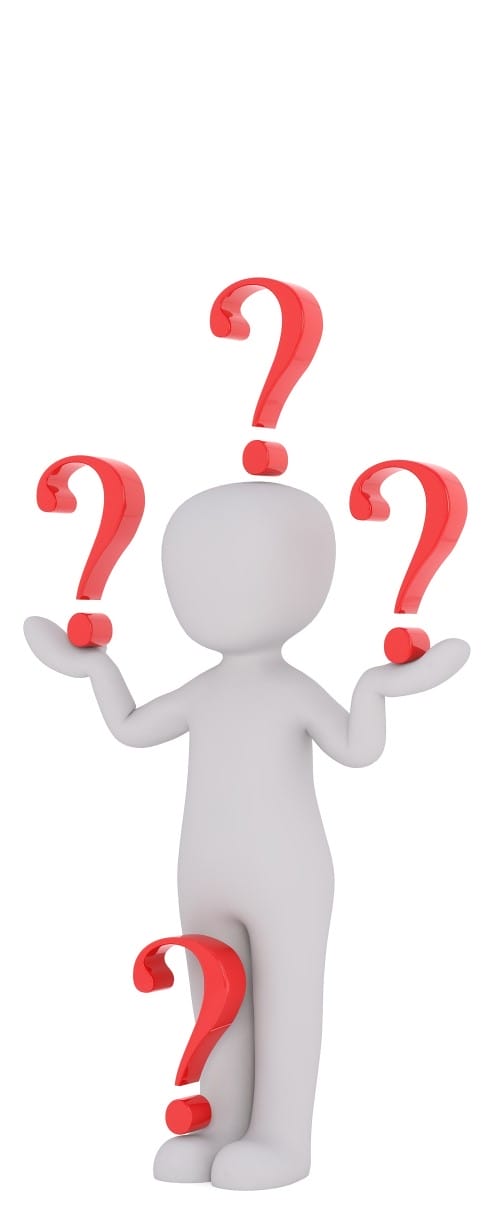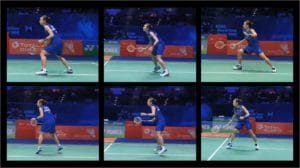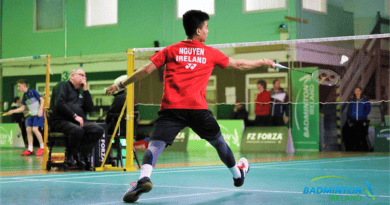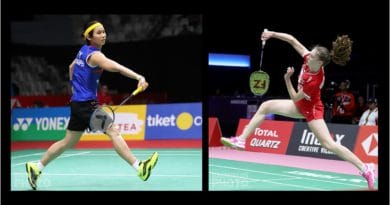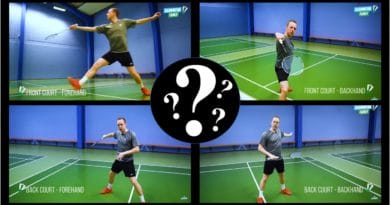18. The Importance of Stances
I wish someone had opened my eyes earlier to Badminton Stances
Only when it was explained did I understand the critical value
Plus, Stances are not the same as ‘Split-steps’
I’d seen these stances but never realised how important they were
Don’t forget to watch the video at the end
– – – – – – – – – – – – – – – –
This post is all about my introduction to badminton stances. The positions that players take up as part of their rally movements
Crucially, these are anticipatory movements into stances that are adopted BEFORE the opponent strikes the shuttle
I came to realise that they are deliberate movements, tactically based, and can easily be coached
This is part of a mini-series, there are links and a video at the end
– – – – – – – – – – – – – – – –
 My story
My story
I walked into the hall and started to watch a coach doing an individual session with a young talented singles player.
During the next 15 minutes, I became aware that I could see things that were new and strange to me. They were practicing something in the deep/rear court from a net flick.
I noticed that they didn’t start each practice rally with a serve. In fact, the coach didn’t seem to start any rallies!
I took out my notebook and started to write.
My notes
- They are only using one shuttle, the player had the shuttle and was starting every ‘rally’
- The coach is standing in a racket-forward position in the Backhand midcourt.
- The practice rally didn’t start with a serve, more like something from the middle of a rally.
- The player steps sideways towards the FH sidelines and hits a ‘block’ feed towards the coach
- The Player then changes from a square stance to a racket foot forward stance landing just before the coach hits the feed
- Coach then flicks towards the backcourt
- Player changes from racket foot forwards by turning and moving backwards to strike the shuttle
My questions
- Why is the player starting every practice?
- Why are they using a block feed to start?
- What is the reason for changing between a square and racket forward stance even though the feed is going to be a flick?
- Surely they would just be more efficient to multi-feed for the strokes rather than all this movement ???
The coach came over and asked what I was writing 🙂
He asked if I had any questions!
– – – – – – – – – – – – – –
Here is a summary of our conversation as I remember it
I asked ….
Why is the player starting?
Why block feed to start?
Why change from square to racket foot forward stance even though the feed is going to be a flick
Are you practicing the shot, the movements to it, or this change of stance?
Why did you not remind or praise the player for their change between stances?
– – – – – – – – – – – – – – – –
Why is the player starting?
“Why not”, came the reply.
“It’s more game-like for this practice and we normally have the player start nearly all our practices. It has many coaching advantages, but I can’t list them all now, let’s talk later”.
“We both enjoy the possibilities that this player start brings to the practice. Plus they bring lots of opportunities and variations for both of us (player & coach).”
I wasn’t sure what he meant by the terms ‘player starts’ and also why they both had variations in the practice, surely the coach was in charge! (I was to be proven wrong on all my thoughts)
– – – – – – – – – – – – – – – –
Why block feed to start?
“It’s a really good way of encouraging the player to use and then change stances as you would in a match”, was the reply.
“This is an essential part of the practice today. It also allows both of us to influence the practice”.
“Stay around, watch and hopefully you’ll see what I mean.”
– – – – – – – – – – – – – – – –
Why change from square to racket foot forward stance even though the feed is going to be a flick
“Ah, now THAT is a good question”, was the reply
“Would you have expected the player to prepare for the shot we are practicing (the shot from the rearcourt)?”
“We want the player to prepare for the shot that will hit the court 1st, so they must (in this case) prepare for my net shot. I will prepare ‘as if’ to play a net and flick then most of the time”.
– – – – – – – – – – – – – – – –
Are you practicing the shot, the movements to it, or this change of stance?
“We are practicing movements and strokes as they would happen in a game”, was the surprising reply to me question
“I’d say that all 3 are important but I change the emphasis from one element to another depending on how the practice is progressing (or not) and where we need to focus”.
“I need to see a change of stance from the initial square defensive (block) to the forward attacking stance as that’s what happens (most of the time) in a real match”.
“The ability to move between these stances in a ‘timed’ way is very important. Probably as important in this practice as any of the other parts. But, I won’t stress that, I’ll just subtly remind them if I need to”.
– – – – – – – – – – – – – – – –
Why did you not remind or praise the player for their change between stances?
“I will praise them for the outcome of the strokes or occasionally mention how good their Early Preparation (EP) was for the stroke” .. he replied.
“But, if we are talking when they change of stance, no, I won’t say very much”
“I don’t need to if it’s working and I certainly don’t want to draw their attention to this ‘automated movement”
“I know through experience that if I do I could ‘harm’ the movement by making them conscious of something they are already doing. This isn’t my aim”.
“The advantages of these stances and the ‘timed changes between them are very important to movement skills and you should not underestimate this”.
The Coach then summarised
“the aim is that they make the practice tough for me,
they prepare in ways that make tactical sense, and play a stroke that limits or hurts me”
– – – – – – – – – – – – – – – –
What happened next
I continued to watch them practice with one shuttle.
Every practice looked like a mini-game.
The player block feeding, the coach preparing ‘as if’ for a net, and then flicking (but not always). The next 10 minutes were just as interesting as the first 15 minutes because I started to see more and more.
Here are more of my notes
- The players’ Block feed seems to vary – sometimes up and over close to the net, sometimes longer and flatter, but the coach doesn’t complain or correct, they just played.
- Stances are changed fluently and seemingly without ‘thought’. I thought, why doesn’t the player just wait in a square stance then move?
- If this is a split-step (?) why aren’t they splitting in the direction they eventually move?
- Why did the coach sometimes play a crosscourt net and try and win the point? I thought they were they were coaching and feeding, not playing to win!!
– – – – – – – – – – – – – – – –
Can you help me with these 4 questions?
 If you were the coach what would you say to my questions?
If you were the coach what would you say to my questions?
I didn’t have time or the courage to ask any of them during that first meeting.
However, they stayed in my notebook for months. I needed to know, I wanted to know!
If you have some thoughts about any of these questions that came from watching this individual coaching session then please email me (contact@badmintonandy.com), I’d appreciate any feedback you have.
That was my introduction to the use of badminton stances in practice.
It probably left me with more questions than answers
– – – – – – – – – – – – – – – –
I came away with these thoughts
- I needed to know more about these player positions, are they part of moving as they seem to be part of the early preparation to move
- I’ve only ever been told about the square (defensive stance), how many others are there?
- Why didn’t the coach want to remind the players about the stances (the technical things) and all the ‘good’ things they were doing?
- How can I introduce stances to my players?
- Where and when do I start?
- Where is the information?
- Is it anticipation, and if so what are they anticipating because the coach is encouraging that they adopt these stances BEFORE the opponent strikes the shuttle.
– – – – – – – – – – – – – – – –
– – – – – – – – – – – – – – – –
If you think that I’ve missed any important points it would be great to hear from you
It would be great to have links to Coach Education or articles that give some detail to compare my ideas
I appreciate all your comments and suggestions, why not send me an email
contact@badmintonandy.com
– – – – – – – – – – – – – – – –
6 Ways to use stances in your badminton movement
This post is for players and will take about 6 mins to read.
It covers the fundamental points about badminton stances, especially in singles. What they are, why you should use them, when they happen, and how you can practice them. Plus why it’s all about the tactical choice you make before your opponent strikes the shuttle.
The coaches guide to badminton stances
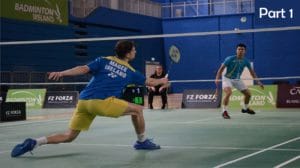 Split into 3 parts, it’s aimed at coaches and those who like lots of detail.
Split into 3 parts, it’s aimed at coaches and those who like lots of detail.
Part 1 : why use stances, what are they. Part 2 : why stances are tactical and anticipatory. Part 3: practice ideas and how to play tactically
Badminton Stances – what do you see?
Your challenge is to watch the video and answer some questions. Examine the footwork, understand how important stances are, where they happen and what happens immediately afterwards.
I’ve posted my thoughts and plenty of statistics for you to consider.
How many times do you think TTY split-steps in the direction she moves?


 My story
My story